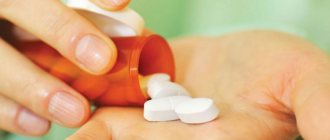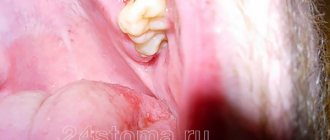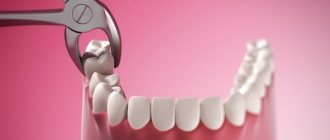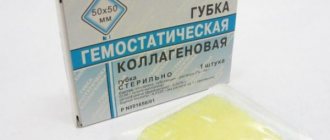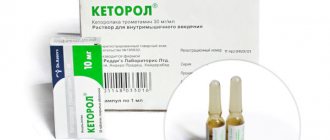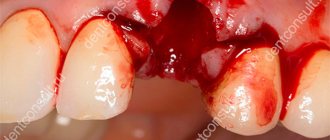A high-quality and rapid wound healing process after tooth extraction depends not only on the professionalism of the doctor who performed the extraction (removal) of the tooth, but on the correct behavior of the patient after the procedure, who must strictly follow the recommendations given by the doctor for the period of healing of the wound surface. If you correctly and clearly follow the advice of a specialist, the recovery process occurs quickly and as painlessly as possible.
For example, patients who do not listen to the recommendations given to them make rinsing movements in the area of the healing wound; this washes out the blood clot, which performs a protective function against the entry of bacteria and microbes, as a result of which there is a high risk of wound suppuration.
In this article we want to give recommendations on what should and can be done after tooth extraction, and what should not be done.
1. A gauze swab on the hole. When can it be taken out?
As a rule, the doctor does not immediately release the patient after removal, but asks him to wait for 15-20 minutes within the clinic to then examine and make sure that everything is in order with blood clotting and the tampon can be removed without fear. In rare cases, keeping the tampon in your mouth may take 30-40 minutes, usually 10-20 minutes. There is no need to keep it longer and it is even dangerous, because bacteria accumulate on it and there is a possibility of infection. There are exceptions, when the wound continues to bleed a little, then the old tampon is replaced with a new sterile one and kept for some time.
For some time, saliva may still be pinkish due to staining with secreted ichor, this should not be alarming, this situation can be distinguished from bleeding. At this moment, saliva can be easily swallowed; there is no need to accumulate it in the mouth.
Nimesil granules d/susp. for oral administration 100 mg pack 2g N30
Registration Certificate Holder
Laboratori GUIDOTTI SpA (Italy)
Dosage form
Medicine - Nimesil® (Nimesil®)
Description
Granules for preparation of suspension for oral administration
in the form of a light yellow granular powder with an orange odor.
1 pack (2 g)
nimesulide 100 mg
Excipients
: ketomacrogol 1000, sucrose, maltodextrin, anhydrous citric acid, orange flavor.
2 g - laminated paper bags (9) - cardboard packs. 2 g - laminated paper bags (15) - cardboard packs. 2 g - laminated paper bags (30) - cardboard packs.
Indications
- treatment of acute pain (back pain, lower back pain; pain syndrome in the musculoskeletal system, including injuries, sprains and dislocations of joints, tendonitis, bursitis; toothache);
- symptomatic treatment of osteoarthritis with pain syndrome;
- algodismenorrhea.
The drug is intended for symptomatic therapy, reducing pain and inflammation at the time of use.
Contraindications for use
- history of hyperergic reactions, for example, bronchospasm, rhinitis, urticaria, associated with taking acetylsalicylic acid or other NSAIDs, incl. nimesulide;
- history of hepatotoxic reactions to nimesulide;
- concomitant (simultaneous) use of drugs with potential hepatotoxicity, for example, paracetamol or other analgesic or non-steroidal anti-inflammatory drugs;
- inflammatory bowel diseases (Crohn's disease, ulcerative colitis) in the acute phase;
- period after coronary artery bypass surgery;
- fever in infectious and inflammatory diseases;
- complete or partial combination of bronchial asthma, recurrent nasal polyposis or paranasal sinuses with intolerance to acetylsalicylic acid and other NSAIDs (including a history);
- peptic ulcer of the stomach and duodenum in the acute phase, a history of ulcers, perforation or bleeding in the gastrointestinal tract;
- a history of cerebrovascular hemorrhage or other bleeding, as well as diseases accompanied by bleeding;
- severe blood clotting disorders;
- severe heart failure;
- severe renal failure (creatinine clearance <30 ml/min), confirmed hyperkalemia;
- liver failure or any active liver disease;
- children under 12 years of age;
- pregnancy and breastfeeding;
- alcoholism, drug addiction;
- hypersensitivity to the components of the drug.
With caution
: severe forms of arterial hypertension, type 2 diabetes mellitus, heart failure, coronary heart disease, cerebrovascular diseases, dyslipidemia/hyperlipidemia, peripheral arterial disease, smoking, CC < 60 ml/min, anamnestic data on the presence of ulcerative lesions of the gastrointestinal tract, infections, caused by Helicobacter pylori; elderly age; long-term previous use of NSAIDs; severe somatic diseases; concomitant therapy with the following drugs: anticoagulants (for example, warfarin), antiplatelet agents (for example, acetylsalicylic acid, clopidogrel), oral glucocorticosteroids (for example, prednisolone), selective serotonin reuptake inhibitors (for example, citalopram, fluoxetine, sertraline).
The decision to prescribe Nimesil should be based on an individual risk-benefit assessment when taking the drug.
pharmachologic effect
Non-steroidal anti-inflammatory drug from the sulfonamide class. Has anti-inflammatory, analgesic and antipyretic effects. Nimesulide acts as an inhibitor of the cyclooxygenase enzyme responsible for the synthesis of prostaglandins and inhibits mainly cyclooxygenase-2.
Drug interactions
Pharmacodynamic interactions:
When used together with glucocorticosteroids, the risk of gastrointestinal ulcers or bleeding increases.
When used together with antiplatelet agents and selective serotonin reuptake inhibitors (SSRIs), such as fluoxetine, the risk of gastrointestinal bleeding increases.
NSAIDs may enhance the effect of anticoagulants such as warfarin. Due to the increased risk of bleeding, this combination is not recommended and is contraindicated in patients with severe coagulation disorders. If combination therapy cannot be avoided, careful monitoring of blood clotting parameters is necessary.
Diuretics
:
NSAIDs may weaken the effect of diuretics.
In healthy volunteers, nimesulide temporarily reduces the excretion of sodium under the influence of furosemide, to a lesser extent the excretion of potassium, and reduces the diuretic effect itself.
The combined use of nimesulide and furosemide leads to a decrease (by approximately 20%) in the area under the congestion curve.
From the respiratory system
: infrequently - shortness of breath; very rarely - exacerbation of bronchial asthma, bronchospasm.
From the digestive system
: often - diarrhea, nausea, vomiting; infrequently - constipation, flatulence, gastritis; very rarely - abdominal pain, dyspepsia, stomatitis, tarry stools, gastrointestinal bleeding, ulcer and/or perforation of the stomach or duodenum; very rarely - hepatitis, fulminant hepatitis, jaundice, cholestasis, increased activity of liver enzymes.
From the urinary system
: rarely - dysuria, hematuria, urinary retention;
very rarely - renal failure, oliguria, interstitial nephritis. General disorders
: rarely - malaise, asthenia; very rarely - hypothermia.
Others
: rarely - hyperkalemia.
special instructions
Undesirable side effects can be minimized by using the minimum effective dose of the drug for the shortest possible short course.
Nimesil should be used with caution in patients with a history of gastrointestinal diseases (ulcerative colitis, Crohn's disease), since exacerbation of these diseases is possible.
The risk of gastrointestinal bleeding, ulceration or perforation of an ulcer increases with increasing dose of NSAIDs in patients with a history of ulcers, especially those complicated by bleeding or perforation, and in elderly patients, so treatment should be started with the lowest possible dose. Patients receiving drugs that reduce blood clotting or inhibit platelet aggregation also have an increased risk of gastrointestinal bleeding. If gastrointestinal bleeding or ulcers occur in patients taking Nimesil, treatment with the drug should be discontinued.
Since Nimesil is partially excreted by the kidneys, its dosage for patients with impaired renal function should be reduced, depending on the level of urination.
There is evidence of rare cases of liver reactions. If signs of liver damage appear (itching, yellowing of the skin, nausea, vomiting, abdominal pain, dark urine, increased activity of liver transaminases), you should stop taking the drug and consult your doctor.
Despite the rarity of visual impairment in patients taking nimesulide concomitantly with other NSAIDs, treatment should be stopped immediately. If any visual disturbance occurs, the patient should be examined by an ophthalmologist.
The drug can cause fluid retention in tissues, so patients with high blood pressure and cardiac problems should use Nimesil with extreme caution.
In patients with renal or heart failure, Nimesil should be used with caution, as renal function may deteriorate. If the condition worsens, treatment with Nimesil should be stopped.
Clinical studies and epidemiological data suggest that NSAIDs, especially at high doses and with long-term use, may lead to a small risk of myocardial infarction or stroke. There is insufficient data to exclude the risk of such events when using nimesulide.
The drug contains sucrose, this should be taken into account by patients suffering from diabetes mellitus (0.15-0.18 XE per 100 mg of the drug) and those on a low-calorie diet. Nimesil is not recommended for use in patients with rare hereditary diseases of fructose intolerance, glucose-galactose malabsorption or sucrose-isomaltose deficiency.
If signs of a “cold” or acute respiratory viral infection occur during treatment with Nimesil, the drug should be discontinued.
Nimesil should not be used simultaneously with other NSAIDs.
Nimesulide can change the properties of platelets, so caution must be exercised when using the drug in people with hemorrhagic diathesis, however, the drug does not replace the preventive effect of acetylsalicylic acid in cardiovascular diseases.
Elderly patients are especially susceptible to adverse reactions to NSAIDs, including life-threatening gastrointestinal bleeding and perforation, deterioration of renal, liver and cardiac function. When taking the drug Nimesil for this category of patients, proper clinical monitoring is necessary.
Like other drugs of the NSAID class that inhibit prostaglandin synthesis, nimesulide can adversely affect pregnancy and/or embryo development and can lead to premature closure of the ductus arteriosus, hypertension in the pulmonary artery system, impaired renal function, which can lead to renal failure with oligodyramnia, to an increased risk of bleeding, decreased uterine contractility, and the occurrence of peripheral edema. In this regard, nimesulide is contraindicated during pregnancy and lactation. The use of the drug Nimesil can negatively affect female fertility and is not recommended for women planning pregnancy. When planning a pregnancy, consultation with your doctor is necessary.
There is evidence of the occurrence in rare cases of skin reactions (such as exfoliative dermatitis, Stevens-Johnson syndrome, toxic epidermal necrolysis) to nimesulide as well as to other NSAIDs.
At the first signs of a skin rash, damage to the mucous membranes or other signs of an allergic reaction, Nimesil should be discontinued. The effect of the drug on the ability to drive vehicles and operate machinery.
The effect of the drug Nimesil on the ability to drive vehicles and operate machinery has not been studied, therefore, during treatment with the drug Nimesil, caution should be exercised when driving vehicles and engaging in potentially hazardous activities that require increased concentration and speed of psychomotor reactions.
Storage conditions
Storage conditions:
List B. Store in a dry place, protected from light and out of reach of children, at a temperature not exceeding 25 °C.
Best before date
Best before date:
2 years.
Do not use after the expiration date stated on the package.
Use during pregnancy and breastfeeding
Restrictions during pregnancy - Contraindicated. Restrictions when breastfeeding - Contraindicated.
Like other drugs of the NSAID class that inhibit prostaglandin synthesis, nimesulide can adversely affect pregnancy and/or embryo development and can lead to premature closure of the ductus arteriosus, hypertension in the pulmonary artery system, impaired renal function, which can lead to renal failure with oligodyramnia, to an increased risk of bleeding, decreased uterine contractility, and the occurrence of peripheral edema. In this regard, the drug is contraindicated during pregnancy and breastfeeding.
Use for renal impairment
Restrictions for impaired renal function - Contraindicated.
In patients with renal failure, Nimesil should be used with caution, as renal function may deteriorate. If the condition worsens, treatment with Nimesil should be stopped. The drug is contraindicated in severe renal failure (creatinine clearance <30 ml/min).
In patients with mild to moderate forms of renal failure (creatinine clearance 30-80 ml/min), there is no need for dose adjustment.
Use for liver dysfunction
Restrictions for liver dysfunction - Contraindicated.
The drug is contraindicated in liver failure or any active liver disease.
Use in elderly patients
Restrictions for elderly patients - Use with caution.
The drug is prescribed with caution to elderly patients. Elderly patients are especially susceptible to adverse reactions to NSAIDs, including life-threatening gastrointestinal bleeding and perforation, deterioration of renal, liver and cardiac function. When taking the drug Nimesil for this category of patients, proper clinical monitoring is necessary.
When treating elderly patients, the need to adjust the daily dose is determined by the doctor based on the possibility of interaction with other drugs.
Use in children
Restrictions for children - Contraindicated.
The drug is contraindicated in children under 12 years of age.
Adolescents (ages 12 to 18 years):
Based on the pharmacokinetic profile and pharmacodynamic characteristics of nimesulide, no dose adjustment is necessary in adolescents.
Terms of sale
The drug is available with a prescription.
Contacts for inquiries
BERLIN-CHEMIE/MENARINI PHARMA GmbH (Germany)
BERLIN-CHEMIE/A.MENARINI LLC
123317 Moscow, Presnenskaya embankment. 10 Business, Block B Tel.; Fax
2. After what time can you eat and drink?
After removal, you can drink water. After two hours you can eat. The limiting condition is not to chew rough food on the side of the extracted tooth in the first few days. Hard food can damage the blood clot, which is located in the socket and is needed for wound healing. If the patient experiences an acute feeling of hunger, then no one forbids eating cool yogurt or kefir. In the first days of healing of the hole, it is better to completely avoid eating rough, hard, solid foods, so as not to make strong chewing movements, as well as spicy, salty foods, so as not to irritate the oral mucosa. It is also important to monitor the temperature of food and drinks; they should not be too hot.
Analogs
If you suffer from toothache, Nimesil is an ideal emergency remedy. However, the German drug is in a high price category (from 600 rubles) and is not always available to patients. What can replace Nimesil? There are a wide range of drugs based on nimesulide that will have a similar effect on the body.
List of medications:
- Aulin;
- Nise;
- Novolid;
- Mesulide;
- Nemulex;
- Flolide;
- Nimulid;
- Mesulide.
- Aponil.
However, this is an incomplete list of drug substitutes. Dozens of drugs are produced based on nimesulide, the availability of which can be obtained from your pharmacist. It is not recommended to choose a generic (medicine substitute) on your own, because the nimesulide content in each drug varies, and only your therapist can choose the correct dosage.
All analogues can be found in pharmacies. Many patients, after taking generics, note that they are completely identical to Nimesil, and are quite satisfied. The main advantage of generics is their significantly lower price with the same method of action.
What is better - Nimesil or generic? The difference between the original and the substitute lies in the composition of excipients (flavors, preservatives) and production features. The increase in the price of the drug depends on the country of production, the equipment used, investment in development, customs duties when transporting across the border and other circumstances. As a result, with the same therapeutic effect, the price differs significantly.
It is important to keep in mind: expensive drugs have not only generics, but also counterfeits. The fake costs a little less than the original, but does not contain the necessary medicinal substances. To avoid buying a useless counterfeit instead of a real drug, you should contact large pharmacies. A reputable pharmaceutical establishment may slightly increase the price of a drug, but will never sell a counterfeit.
Another group of drugs
In addition to nimesulide-based medications, there is another group of drugs with similar effects. These drugs have an analgesic effect, but they contain other active agents. Substitute drugs are prescribed if the use of Nimesil is prohibited. These include the following medications:
- Indomethacin;
- Meloxicam;
- Amtolmetin;
- Diclofenac;
- Diacerin.
These medications may have other names and their own analogues. Only your therapist can understand so many drugs, so trust him with the choice. Any medication is selected taking into account the characteristics of the patient’s body, the presence of chronic ailments, age and characteristics of the perception of medicinal substances.
Remember that self-medication carries the risk of complications of chronic illnesses or the emergence of a new disease. Potent chemicals always have side effects on the systems and organs of the human body, so there is no need to experiment on yourself. No one knows what the consequences of taking a medication that has not been approved by your doctor might be. All responsibility will fall on you.
Sources used:
- Khan RA, Rahman SZ Nimesulide Induced Coronary Artery Insufficiency – A Case Report (English) // J Pharmacovigilance Drug Safety : journal. — 2004.
- Anesthesia in dentistry / S.F. Gritsuk. - M.: Medical Information Agency (MIA), 1998.
- https://www.ncbi.nlm.nih.gov/books/NBK547948/
3.Applying ice.
After tooth extraction in our Center, a specialist will give you ice specially prepared for such procedures to apply in the first hours after extraction. Ice is applied for a certain time, at certain intervals, which the doctor will instruct you about. At home, this procedure will need to be continued for some time (the first few hours after removal). This is done in order to minimize or completely eliminate tissue swelling.
Under no circumstances should you heat the area in the area of the extracted tooth; in this case, suppuration will develop.
6. Medications after removal.
After the procedure, the doctor prescribes a number of medications to take. Under no circumstances should you take any medications on your own, without consulting a doctor.
Painkillers should be taken in case of pain, at intervals and in the amount recommended by the doctor. Each case is individual; it happens that the patient does without taking painkillers.
Antibiotics. In some cases, after removal, antibiotics are prescribed for 5-7 days. As a rule, these are situations when the doctor removes a tooth in the stage of inflammation, complex extraction or removal of several units of teeth. Only a specialist surgeon decides whether to take antibiotics or not.
Antihistamines. Reduces the likelihood of swelling.
Antiseptics. Used as a rinse. BUT, remembering that rinsing movements are prohibited in the first days. A small amount of solution is taken into the mouth and simply held in the mouth, then calmly spit out. Such baths must be done if the tooth was removed during the inflammation phase, if the flux was exposed, if there are teeth affected by caries in the oral cavity.
Indications for use
Nimesil is recommended for use for various pain syndromes. These may be sensations caused by the onset of menstruation, surgery, head diseases and dental problems. The drug is used to eliminate pain arising from the following pathologies:
- Gynecological
- Vascular
- Urological
Nimesil is used for pain, including toothache.
Nimesil demonstrates good effectiveness in eliminating pain caused by dysfunction of the musculoskeletal system. In addition to the main effect that the drug has, it is able to restore body temperature, regardless of the reasons that caused its increase.
Nimesil is often prescribed for toothache due to the fact that the drug has a powerful effect in relieving pain. Dentists resort to this drug because it quickly eliminates discomfort for quite a long time.
The active ingredient of the drug is nimesulide. If there is individual intolerance to individual components of Nimesil, it can be replaced with Nise, Nimica, Nimesulide, Aponil or Prolide, each of which is available in tablet form. There is another analogue called Nemulex. It is produced in powder form.
7.High blood pressure.
In patients with high blood pressure, there is a risk that the wound may bleed longer than usual. In this case, you need to regulate the pressure by taking appropriate medications to reduce it. In our SDent dental medical center, even before the start of manipulations, the doctor always finds out the main points about the general health of the patient. If the patient has hypertension, the specialist knows about this problem in advance and then gives the necessary recommendations appropriate to the case.
8.What happens to the sutures after removal.
After the tooth is removed, the surgeon places sutures on the wound surface. This promotes faster healing, reduced pain, less risk of inflammation, minimizes the risk of bleeding, and protects the blood clot from falling out.
At the SDent clinic we use the most modern and safe materials. The thread with which the surgeon sews the edges of the hole is self-absorbing. But during the process, the ends of the thread can cause discomfort to the patient and interfere with the oral cavity. Therefore, for the comfort and safety of the patient, the doctor always sets an appointment date for examination and removal of sutures in approximately 10 days.
Description of the drug
Nimesil belongs to a new generation of medications and is not known to all patients. Many people prefer to use proven analgesics for years - paracetamol and analgin. How does Nimesil differ from the listed tablets? The active medicinal agent in the drug is nimesulide, which has the following characteristics:
- quickly relieves pain impulses;
- stops the inflammatory process.
This drug was intended for the treatment of inflammatory processes in the joints, and is now prescribed for osteochondrosis, arthritis and arthrosis. The advantage of the drug over other analgesics is the absence of an aggressive effect on the gastrointestinal mucosa. The medicine acts for its intended purpose without interfering with the functioning of other body systems. Nimesil only blocks the production of enzymes that organize the development of the inflammatory process in tissues.
The drug is used in the form of a powder diluted with water. the resulting suspension has a pleasant taste and aroma of exotic fruits. The drug stops pain impulses for a long time, depriving a person of sensitivity to pain. For this reason, dentists do not recommend drinking Nimesil suspension for toothache before visiting the office, since it is difficult to determine the affected area. But after dental treatment or tooth extraction, Nimesil will provide an invaluable service.
After tooth extraction, you should not do the following.
- In the first couple of days, taking a hot bath is excluded, only a warm shower.
- During sleep, you need to be careful not to lie on the side where the tooth was removed, this provokes the appearance of swelling.
- Visiting the gym and active physical activity should be postponed in the first days.
- Do not touch the wound with your tongue or foreign object.
- Do not open your mouth very wide, do not use active chewing and facial movements to avoid the sutures coming apart.
- Aspirin is not suitable as an anesthetic due to the fact that it has a thinning effect on the blood and may cause bleeding and hematoma.
- Do not rinse during the first few days. This can negatively affect the loss of a blood clot from the socket and the occurrence of inflammation.
For more information and to make an appointment with a specialist, call:
+7,
How to take Nimesil
Usually a twice daily dose is prescribed. A single dose is equal to one sachet of Nimesil. The drug dissolves in about one hundred milliliters of warm water. The suspension is drunk all at once after meals. The prepared solution cannot be stored and consumed after some time. Based on the results of monitoring the effectiveness of treatment and the severity of the patient’s condition, the dose may be increased.
Nimesil and pregnancy
Nimesil is not prescribed during pregnancy or lactation; it is contraindicated for a number of reasons. The drug provokes pregnancy complications and significantly inhibits the development of the fetus. Even small doses of Nimesil can lead to miscarriage and abnormal development of the fetus with serious consequences for the future health of the mother.
Nimesil and childhood
The drug is also contraindicated for children under 12 years of age. After 12 years, Nimesil is prescribed in the same dosage as for adults.
Nimesil in the elderly
Nimesil is prescribed to elderly patients with extreme caution. This category of patients is more susceptible than others to side effects from taking medications. In addition, older patients often already have a number of serious diseases, and taking the drug can only worsen the condition. Therefore, Nimesil is prescribed to older people in individual dosages. The treatment takes place under the strict supervision of a doctor.
Nimesil and chronic diseases
In the presence of a number of chronic diseases (heart, liver and kidney diseases), Nimesil is contraindicated. In other cases, in the presence of chronic diseases and the need to take the drug, treatment also takes place under the strict supervision of a doctor and regular laboratory tests of blood parameters and others. Nimesil is regularly prescribed for chronic rheumatic diseases.
Nimesil is one of the most effective medicines today. In addition to a pronounced analgesic effect, the drug is actively used for colds and ARVI as an antipyretic. Plus, clinical studies have found that even with an impressive list of contraindications, Nimesil is easier to tolerate, and the risk of side effects is much lower than other non-steroidal anti-inflammatory drugs.
